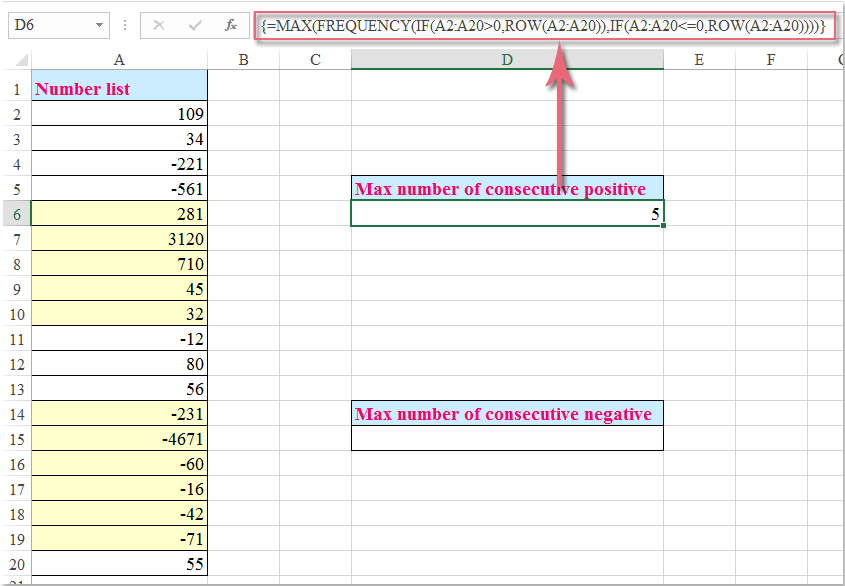Πώς να μετρήσετε τον μέγιστο αριθμό διαδοχικών θετικών / αρνητικών αριθμών στο Excel;
Εάν έχετε μια λίστα δεδομένων που συνδυάζονται με θετικούς και αρνητικούς αριθμούς και τώρα, θέλετε να μετρήσετε τον μέγιστο αριθμό διαδοχικών θετικών και αρνητικών αριθμών όπως φαίνεται στο παρακάτω στιγμιότυπο οθόνης, πώς θα μπορούσατε να αντιμετωπίσετε αυτήν την εργασία στο Excel;

Μετρήστε τον μέγιστο αριθμό διαδοχικών θετικών και αρνητικών αριθμών με τύπους πίνακα
Μετρήστε τον μέγιστο αριθμό διαδοχικών θετικών και αρνητικών αριθμών με τύπους πίνακα
Για να λάβετε τον μέγιστο αριθμό διαδοχικών θετικών και αρνητικών αριθμών, εφαρμόστε τους ακόλουθους τύπους πίνακα:
Μετρήστε τον μέγιστο αριθμό διαδοχικών θετικών αριθμών:
Εισαγάγετε αυτόν τον τύπο σε ένα κελί όπου θέλετε να λάβετε το αποτέλεσμα:
=MAX(FREQUENCY(IF(A2:A20>0,ROW(A2:A20)),IF(A2:A20<=0,ROW(A2:A20)))), και στη συνέχεια πατήστε Ctrl + Shift + Εισαγωγή πλήκτρα μαζί και θα λάβετε το σωστό αποτέλεσμα όπως χρειάζεστε, δείτε το στιγμιότυπο οθόνης:

Μετρήστε τον μέγιστο αριθμό διαδοχικών αρνητικών αριθμών:
Εισαγάγετε αυτόν τον τύπο σε ένα κελί όπου θέλετε να λάβετε το αποτέλεσμα:
=MAX(FREQUENCY(IF(A2:A20<0,ROW(A2:A20)),IF(A2:A20>=0,ROW(A2:A20)))), και στη συνέχεια πατήστε Ctrl + Shift + Εισαγωγή ταυτόχρονα και θα λάβετε το αποτέλεσμα όπως χρειάζεστε, δείτε το στιγμιότυπο οθόνης:

Note: Στους παραπάνω τύπους, A2: A20 είναι η λίστα των κυψελών που θέλετε να χρησιμοποιήσετε.
Τα καλύτερα εργαλεία παραγωγικότητας γραφείου
Αυξήστε τις δεξιότητές σας στο Excel με τα Kutools για Excel και απολαύστε την αποτελεσματικότητα όπως ποτέ πριν. Το Kutools για Excel προσφέρει πάνω από 300 προηγμένες δυνατότητες για την ενίσχυση της παραγωγικότητας και την εξοικονόμηση χρόνου. Κάντε κλικ εδώ για να αποκτήσετε τη δυνατότητα που χρειάζεστε περισσότερο...

Το Office Tab φέρνει τη διεπαφή με καρτέλες στο Office και κάνει την εργασία σας πολύ πιο εύκολη
- Ενεργοποίηση επεξεργασίας και ανάγνωσης καρτελών σε Word, Excel, PowerPoint, Publisher, Access, Visio και Project.
- Ανοίξτε και δημιουργήστε πολλά έγγραφα σε νέες καρτέλες του ίδιου παραθύρου και όχι σε νέα παράθυρα.
- Αυξάνει την παραγωγικότητά σας κατά 50% και μειώνει εκατοντάδες κλικ του ποντικιού για εσάς κάθε μέρα!

